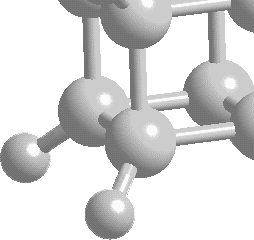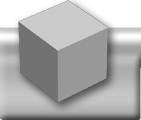Sytematic
Name: Pentacyclo[4.2.0.02,5 03,8. 04,7]octane
CAS
Number: 277-10-1

Since
it's synthesis in 1964, cubane has been thought to have
a novel, yet exceptional structure which, at first, defied
chemical logic. This lead to many studies of its nature,
resulting in the publication of the physical properties.
A selection of which are shown below:
C-C
Distance |
|
1.5727
± 0.0019 Å |
C-H
Distance |
|
1.118
± 0.008 Å |
Colour |
|
Transparent |
Toxicity |
|
Nontoxic |
Stability |
|
Inert
to light, water and air |
Decomposition |
|
>
220 ºC |
Density |
|
1.29
g cm-3 |
Vapour
Pressure |
|
1.1
mm (25 ºC) |
Melting
Point |
|
130
- 131 ºC |
Boiling
Point |
|
133
ºC |
Solubility |
|
18
wt % (hexane) |
Heat
of formation |
|
+
144 kcal mol-1 |
Strain
Energy |
|
166
kcal mol-1 |
It
can be seen that the average C-C bond length in cubane,
is very similar to that of cyclobutane yet both the Heat
of formation and the Strain Energy are much, much greater
than those in similar compounds like octane (Heat of formation
of Octane 50 kcal mol-1, Strain Energy of Octane
26 kcal mol-1). This illustrates the effect
that the strained 90º bond angles have upon the system
and why, therefore, it is so remarkable that cubane can
even exist.
|



